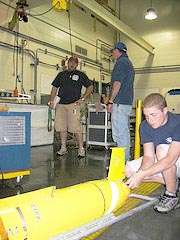Flying Underwater, Staying Dry

Rutgers physical oceanographer Scott Glenn and his students are flying a submersible robot glider, the Scarlet Knight, across the Atlantic – very slowly, underwater, and without getting wet.
“The nice thing about the gliders is that they can go to extreme environments that scientists can’t go to,” Glenn said. “They can stay at sea for longer than scientists can. And they can be in more than one place at once.”
The Scarlet Knight is one of 22 gliders in the Rutgers fleet. They are ocean-observing systems, carrying various sensors in their science bays. Those sensors measure physical properties like the water's temperature and salinity. Usually, gliders are deployed simultaneously with other ocean-observing systems, such as high-frequency radar and satellite data, to form a holistic picture of a given piece of the ocean. Satellite data might show sea-surface temperature, for instance, and radars would show the direction and speed of surface currents. All these pieces of the puzzle are necessary, Glenn said, to understand a constantly changing ocean environment.
Sitting at computer terminals in their lab, the researchers are piloting the glider remotely from its launch point off Atlantic City to Vigo, in northwestern Spain. The Scarlet Knight, having flown more than 5,000 kilometers – farther than any previous glider flight in history– is surfing the currents northwest of the Azores.
The submersible is one of 22 gliders in the Rutgers fleet. They are ocean-observing systems that serve as platforms for an array of sensors. Like the other gliders in the fleet, the Scarlet Knight moves by changing buoyancy. A small electric motor operates a pump, which sucks in water through tiny holes in the nose. The nose dips, the glider sinks, and its delta wings turn the downward motion into forward motion. At its preprogrammed depth, the pump spits out the water. The nose rises, the glider ascends, and the wings turn the upward motion into forward motion.
The glider “roller-coasters” through the water at speeds measured in centimeters per second. Every few hours, the glider pops out of the water and calls the lab with a satellite phone in its tail. It sends email, telling the lab its position and downloading data it has gathered, and then waits for instructions.
The Scarlet Knight uses long-life lithium batteries. Even so, the batteries that power the pump, the sensors and the satellite phone will die soon. Four of Glenn’s undergraduates are traveling to the Azores to retrieve the submersible, take it into port, change its batteries, clean its hull, and send it back on its way to Vigo, Spain.
Provided by Rutgers University



















